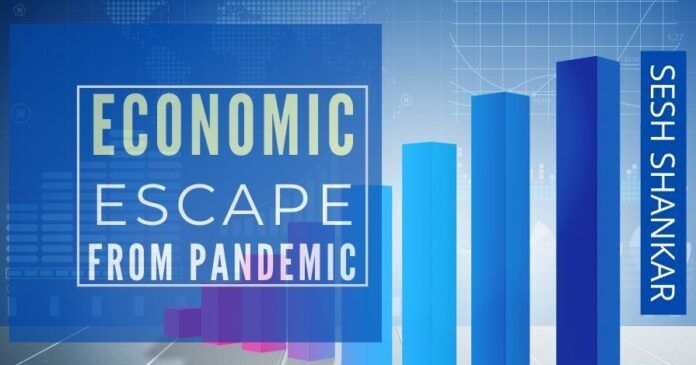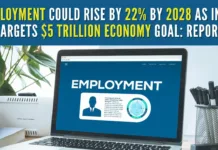

India’s GDP will Drop
Even before the pandemic, India’s GDP growth rate was on the decline. This is even as per the Government of India sources. Most rating agencies had predicted the growth rate to be around 5%. Post the pandemic lockdown, most agencies predict the GDP to fall even further to around 2.5%. Even this is predicated on a number of assumptions. Chiefly premised on making cheap credit available, producers will produce and consumers will show up because they also have access to cheap funds.


In a recent blog, IMF predicts India’s GDP to fall even further to 1.9% in FY20[1]. The economic impact of the pandemic is far greater than anything we have seen recently including the global financial crisis.

What will be the Human Behaviour post the pandemic? A sense of victory, elation, and a gung-ho spirit? It is unlikely that we will have a final ‘victory’ for a long time, much less a sense of elation. Maybe a quick vaccine or cure discovery will change all that. But the new norm is equally likely to be dreading the next pandemic around the hidden corner and a huge drop in GDP unless dramatic measures are undertaken.
Percentage of Indian Population Below Poverty Line
The poverty line is a poor target. It has also been occasionally hit for a six by Tendulkar. Suresh Tendulkar (Indian economist). The UN defines absolute property as not just based on income but also access to basic social services. We chose a poverty line based on calories and how much money is needed to buy those calories. Any analysis of India’s poverty shows that even with very low thresholds, millions are below the poverty line[2].

Prime Minister Modi promised to eradicate poverty by 2022 as part of his ‘New India’ vision. There is a variety of research done on the impact of GDP including by ADB[3]. A simple reasonable assumption is that the degradation of 1-3% in GDP will result in 30–60 million additional people falling below the poverty line.
What is abundantly clear is that unless drastic measures are undertaken we will add tens of millions back to below the poverty line.
Vicious Cycle of Under-Confidence:
Increased economic activity or capital formation happens with positive confidence about the future. This cannot happen purely with mixed demand-supply drivers like increased credit availability. The government needs to break out of this by big, bold capacity building growth initiatives. A classic example is Atal Bihari Vajpayee’s Golden Quadrilateral project.
As per various studies released by Reserve Bank of India and others, the confidence index was already dropping in March[4]. COVID-19 and lockdown are going to significantly erode this further. There is a definite correlation between these sorts of confidence indices and actual economic growth. However, there is little evidence to suggest that sliding confidence in the future is going to be stopped by only making increased credit available. Optimism for the future is created by strong signaling. When the big boys exude confidence in the future, it has a rippling effect right through the economy. Conversely, no amount of credit or capacity building will get an MSME to convince a large enterprise to buy more. So if we need to start a ripple, the biggest boy of them all, the government needs to step up to the crease.

Government spend and removal of fiscal deficit targets
Under usual circumstances fiscal deficit targets are important. When we incur fiscal deficits, we essentially are telling our children that they will have to pay the bill for our profligacy today. Using Fiscal deficit to climb out of a depression is not new. Between the depression and the war, the US drove fiscal deficit up from 4.5% of GDP in 1932 to 26.8% in 1943. But it also propelled it to become the largest economy by far. With a falling GDP and collections and clamor for quick tax refunds etc. it is unlikely the government will meet it’s fiscal deficit targets. The FRBM Act was brought in 2003 under the NDA government with good intentions to avoid unproductive freebies by governments. The UPA government observed it in the breach and sent it up to 5.7% by FY12. When the whole country was pinning its hopes on the grand economic upswing under PM Modi in 2016, the FM at that time Jaitley, thought it fit to bear the cross of the sins of the UPA and set us on a perilous, aggressive fiscal deficit target of 3% by FY18. This choked economic growth while the targets were still elusive. So the government brought in the NK Singh committee and tried to buy itself time till FY20 for the 3% target. Those targets were still elusive even before the pandemic.
The single most important decision the Government can make is to remove these self-imposed fiscal deficit foot cuffs. Else National economy can neither run nor stand for long.
But what should the government spend on? 6 audacious ideas in brief:
- Smart Cities and Construction: When the NDA Government was formed in 2016. There was a lot of talk about ‘smart cities’. For most, this conjured up visions of a 100 Singapores’ in India. What has happened is actually quite tragic and has come to mean things like some software for e-delivery of municipal services. What if there was a bold enough imagination to say 10 cities of 10 million population in 10 years and we will spend $100 BNs a city over the ten years. This would straight away bump GDP by over 5% points year after year. It is important that these cities are ‘smart’. So they are instrumented, interconnected, and intelligent. More importantly, they represent the rich architectural history of our civilization and don’t become clones. Even more important, design and construction reflect new ways of ‘producing and industrializing’ construction. But most importantly, each new ‘smart city’ has a golden compass. One is an ‘Electronics City’, another a ‘Defense City’ another a modern Nalanda or ‘Education City’ and so on. Not that other economic activities will not happen in such cities but the moment there is a compass the design follows and the kernel of economic activity gets germinated automatically by the government.
- Defense Self-sufficiency and Exports: After being plagued by years of indecision under UPA, the NDA Government has moved aggressively on procurement. The domestic production infrastructure is so degraded that most of the spending has been on foreign procurement. Some of these have ‘offset’ requirements and these flow to some major Indian business conglomerates. It is interesting that we have a super-successful ISRO and then a HAL next door, which is the exact opposite of what super-successful is. The government must be seized on how to tackle this quickly. There is however a third important leg, where the government could channel the innovation capability and also harvest intellectual property to further accelerate the make in India mission. Despite several measures like domestic purchase norms etc. the defense production and support industry aren’t getting broad-based. MSMEs have several limitations in accessing the defense market. The start point is defining theatre imperatives of the future. For example, what does an ideal soldier in Siachen look like? Let us say he is human. What does the clothing of the future look like? This can be crowd-sourced as a defense hackathon. Companies and teams participate, there is funding for various stages of development and then teams are given the option to coalesce so that there are finally 2 teams left standing who deliver to these requirements. The government assures revenue streams and profits and has deep interests in these SPVs. So a mammoth ‘Defense Accelerator’ if you will. Many of these technologies can be harvested for civilian use so that the overall technology capability in the country improves. To ensure the Defense establishment fully embraces the program, declare another $10 BN available for purchases that come through the Defense Accelerator program, outside of regular budgets, and the cup will be filled as it empties.
- Manufacturing and Auto: Despite declaring grand plans to ‘Make in India’, it is unclear how this looks or is differentiated from other countries. The government took one step forward and two steps back on ‘green’ vehicles Also, what does a certified ‘Manufacture in India’ brand mark promise? Only an assured market or strong policy regime can bring in disruptions and step-changes. Pick a pill or two and let’s go all in. What does 3D printing a car look like? We already have many 3D printed bridges around the world. What do next-generation industrial robots look like? Countries are already advancing such technologies and we seem unsure about what gives us manufacturing edge. UAE as an example has declared its intention of using 3D as a core part of its strategy to be the world leader in the 4th generation Industrial revolution. Organizations like the Central Manufacturing Technology Institute don’t seem to have either the resources of cutting edge labs or sufficient Industry traction. It is imperative the government set policy for what it will ‘buy’ but also what next-generation industrial manufacturing standards look like for ‘Made in India’ hallmark both from a process and product standpoint. A six-step punch looks like this (i) Set a policy road-map for manufacturing standards (ii) Co-opt Industry to identify gaps in technology (iii) Setup a nodal high-quality advanced manufacturing lab, funded by Government. (iv) Co-opt engineering and research teams across the industry. Pick a nice number, say $1 BN per year as investment commitment. (v) Make available technologies for free to Indian companies aspiring for ‘Manufactured in India’ tag. (vi) Keep raising standards
- Electronics: Electronics are ubiquitous in today’s world. How can India dominate or even be a player in the global scheme of things without a single public fab? The one single fab in India is an ISRO facility. This is so straightforward. Commit to a minimum of $100 BN in creating fabs either directly or in partnership with the global industry. Use that as the kernel to build an entire ‘Electronics Smart City’ of a steady-state population of 10 million. Provide incentives and encourage all ancillary industries to gravitate to such a City.
- Transportation and Storage Chains: Although estimates vary, directly and indirectly, Vajpayee’s Golden Quadrilateral added several percentages to the GDP. The government must seriously step up investments in roads, railways, and waterways. Especially for the movement of freight. Especially with Railways, we must leapfrog on a war-footing. On a side note, given the forward-looking decision not to have a separate Railways budget, it would be useful to consolidate all modes of Transportation under one ministry. This way holistic decisions are possible without sub-optimization. On Roadways, we have a misleading road density of 115 km per 100 sq. km of land, comparable to several advanced countries. But less than 2% of those are highways and they carry 40% of the road traffic. GST has had a positive impact on the movement of goods, similarly, over the last few years, the stalled progress on roadway projects has been reignited. We increased the rate of construction from about 12 Km a day five years back to more than double at 30 km per day. But for us to get to world-standards we need to build at this pace for the next 20 odd years. Nice targets would be an additional 100,000 Kms of Highways in the next 5 years; increase rail track capacity and another 10,000 freight trains in the next 5 years; increase target from 100 MT in FY21 to 500 MT of inland waterways by FY25. The other core pillar is cold storage chains and markets for farmer security. This has been discussed to death ad nauseam but there is little momentum on the ground. Hopefully, the National Logistics policy which is in the anvil addresses this but with a critical focus on ensuring economic security for farmers and food security for people in Urban agglomerations.
- Water Security: Even if we survive the pandemic, there are many predictions about the next wars being about water. Inter-Linking of rivers (ILR)[5], leveraging our gift of extensive coastlines, providing pure clean water to all households, and sustainable water regeneration is 4 important dimensions. A consistent recent phenomenon in India has been floods in some pockets and simultaneous droughts in others. The ILR initiative was undertaken with lofty ambitions and limited budgets. In the spirit of competitive federalism, the government can declare $20 BN to be spent in the next 5 years on projects that are most quickly supported by State Governments. This combined with micro-irrigation projects under MNREGA will dramatically improve farmer security and agricultural productivity.
Direct benefits to the underprivileged sections tied to increased economic activity
Any launch, especially a big bang launch on a war footing cannot happen on an empty stomach. The government has already taken several commendable steps in this direction. For example, the 1.7 lakh crore relief package announced towards the end of March. The bulk of it was in the nature of direct benefits to the marginalized.
It is also necessary to significantly induce a booster dose and scale the MNREGA program and tie it to an economic activity like micro-irrigation.
Similar to the Ayushman program, maybe, in addition, the government can introduce an ‘unemployment insurance’ cover as social security.
But there are 4 types of constituencies who are most affected by the pandemic.
- Rural population
- Migrant workers and laborers in the unorganized sector
- Independent proprietors/traders
- Small and Medium business owners and employees
Most of the government actions so far have addressed mainly the first two categories. Many countries, like Canada as an example, have taken path-breaking steps to pay a significant percentage of the wage bills of smaller entities[6].
It is unclear when these smaller entities/proprietorships will start seeing revenue streams but they are stuck with payroll and other costs. Many of these entities have loans from outside the regular banking systems and if it is from regular banks/NBFCs, then they are backed by immovable collateral. We run the real risk of not just a liquidity crisis but also a solvency crisis for these entities. They are going to have to cut payroll or salaries at some point. Also liquidating collaterals are not going to be easy in a subdued economy. NPAs of the banking sector is going to explore further. Infusing liquidity by the RBI is important, but by itself, it is going to be like trying to catch one’s tail, faster and faster[7]. The Government must underwrite the expenses for a period of 6 months. A simple solution is a software that looks at the applicable categories of IT returns and does formulae based ‘pandemic relief’ payment.
Summary
True challenges are when the mettle of leaders is tested. Challenges provide opportunities for leaders to leapfrog and the pretenders to hide. This pandemic is certainly a massive challenge. Incrementalism and tinkering at the edges are the hallmarks of a bureaucracy. But equally some of our brightest and best are bureaucrats. Similarly, a lot of hope is riding on our political leadership and PM Modi to demonstrate that he is a transformational leader. Hopefully, history will record that we dared to dream and dared to try.
Note:
1. The views expressed here are those of the author and do not necessarily represent or reflect the views of PGurus.
References:
[1] The Great Lockdown: Worst Economic Downturn Since the Great Depression – Apr 14, 2020, Imf Blog
[2] Poverty Estimation in India – Oct 10, 2019, Drishti
[3] Poverty Impact of the Economic Slowdown in Developing Asia: Some Scenarios – ABD
[4] RBI – Monetary Policy Report – April 2020 – Apr 09, 2020, RBI
[5] INTERLINKING OF RIVERS – MOWR
[6] Government Announces Details of the Canada Emergency Wage Subsidy to Help Businesses Keep Canadians in their jobs – Apr 1, 2020, Government of Canada
[7] RBI – Governor’s Statement – Apr 17, 2020, RBI
- The uneducated Hindu - May 15, 2020
- V shaped economic recovery - May 9, 2020
- Economic escape velocity from a pandemic - April 29, 2020











Sir, you may like to reduce the typos by offloading the proof-reading to others who may like to contribute (without compensation). Regards.
Brilliant article. Very well articulated ideas which have great potential if implemented in toto.
Will the ideas tossed up in this article walk through bureaucratic desks for implementation? A million $ question. Tragedy is QUESTION it will be in the end.